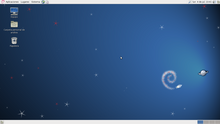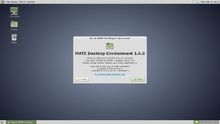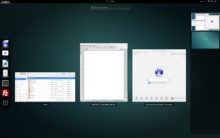Debianのバージョン履歴

Debianは、固定されたスケジュールでリリースされていない。近年のリリースは、おおよそ2年ほどをかけて、Debianプロジェクトによって作られている。
Debianディストリビューションのコードネームは、トイ・ストーリーの映画に登場するキャラクターの名前から取られている。Debianの非安定版(unstable)はSidと名付けられており、これは彼の玩具を破壊するキャラクターの名前である[1]。
リリースの歴史[編集]
Debian 1.0は、リリースされていない。これは、ベンダーが誤って開発版のリリースをこのバージョンナンバーで出荷してしまったからである。パッケージ管理システムのdpkgとそのフロントエンドdeslectは、Debianにおいては以前のリリースで開発、実装済みであった。a.outバイナリからELFバイナリへの移行は、計画されていた1.0のリリース以前から既に始められていた。また、唯一サポートされていたアーキテクチャはIntel 80386(i386)であった[2]。
Debian 1.1 (Buzz)[編集]
Debian 1.1(Buzz)(バズ)は、1996年6月16日にリリースされた。このリリースには474個のパッケージが含まれている。Debianは、ELFバイナリフォーマットへの移行を完了させ、Linuxカーネル2.0を使っていた[3]。
Debian 1.2 (Rex)[編集]
Debian 1.2(Rex)(レックス)は、1996年12月12日にリリースされた。このリリースには848個のパッケージが含まれており、これは120人の開発者によりメンテナンスされていた[4]。
Debian 1.3 (Bo)[編集]
Debian 1.3(Bo)(ボー)は、1997年6月5日にリリースされた。このリリースには974個のパッケージが含まれており、これは200人の開発者によりメンテナンスされていた[5]。
Debian 2.0 (Hamm)[編集]
Debian 2.0(Hamm)(ハム)は、1998年7月24日にリリースされた。このリリースには1500個のパッケージが含まれ、これは400人を越す開発者によってメンテナンスされていた。libc6への移行が行われ、DebianはMotorola 68000シリーズ(m68k)アーキテクチャへの移植が行われた[6]。
Debian 2.1 (Slink)[編集]
Debian 2.1(Slink)(スリンキー)は、1999年3月9日にリリースされ、これは2250個のパッケージを含んでいた。パッケージ管理のフロントエンドとしてAPTが導入され、AlphaとSPARCへの移植が行われた[7][8]。
Debian 2.2 (Potato)[編集]
Debian 2.2(Potato)(ポテト)は、2000年8月14日から15日にかけてリリースされ、450以上の開発者によってメンテナンスされる2600のパッケージを含んでいた。新しく含まれたパッケージには、ディスプレイマネージャのGDMや、ディレクトリサービスのOpenLDAP、セキュリティソフトのOpenSSHまた、メール転送エージェントのPostfixなどが含まれる。Debianは、PowerPCとARMアーキテクチャに移植された[9][10][11]。
Debian 3.0 (Woody)[編集]
Debian 3.0(Woody)(ウッディ)は、2002年7月19日にリリースされ、900を超える開発者によってメンテナンスされる8500前後のパッケージを含んでいた。KDEが導入され、IA-64、PA-RISC、MIPS、s390のアーキテクチャに新たに移植された[12][13][14]。
Debian 3.1 (Sarge)[編集]
Debian 3.1(Sarge)(ソルジャー)は、2005年6月6日にリリースされ、おおよそ15400のパッケージを含んでいた。このリリースでは、debian-installerとOpenOffice.orgが新たに含まれた[15][16]。
Debian 4.0 (Etch)[編集]

Debian 4.0(Etch)(エッチ)は、2007年4月8日にリリースされ、1030人以上の開発者によってメンテナンスされる、おおよそ18000のパッケージを含んでいた。Debianは、x86-64に移植されたが、m86kアーキテクチャへのサポートは廃止された[17][18]。このバージョンでは、UTF-8とudevによるデバイス管理がデフォルトとなった。
Debian 5.0 (Lenny)[編集]

Debian 5.0(Lenny)(レニー)は、2009年2月14日にリリースされ、23000個以上のパッケージを含んでいた。Debianは、armelアーキテクチャに移植された[19][20][21]。
Debian 6.0 (Squeeze)[編集]

Debian 6.0(Squeeze)(スクイーズ)は、2011年2月6日にリリースされ、29000個以上のパッケージを含んでいた。ウェブブラウザのChromiumが新たに含まれ、kfreebsd(i386とamd64、後にサポートは中止される)への移植が行われた。また、Intel 486、Alpha、PA-RISCアーキテクチャへのサポートが中止されている[22][23][24][25]。
Squeezeは、ノンフリーなファームウェアのコンポーネント("バイナリーブロブ"として知られる)がポリシーの問題により、mainレポジトリから除かれた最初のリリースである[26][27][28][29]。
Debian 7 (Wheezy)[編集]

Debian 7(Wheezy)(ウィージー)は、2013年5月4日にリリースされ、36000個を超えるパッケージを含んでいた。UEFIのサポートが追加され、armhf、s390xアーキテクチャのサポートが追加された[30][31][32]。
Debian 8 (Jessie)[編集]

Debian 8(Jessie)(ジェシー)は、2015年4月25日から26日にかけてリリースされ、43000個を超えるパッケージを含んでいた。このリリースでは、systemdがinitの代わりにデフォルトでインストールされている。(sysvinitとupstartパッケージも代替の選択肢として提供されている)。DebianはARM64とppc64leアーキテクチャに移植されたが、IA-64、kfreebsd、s390、SPARCのサポートが中止された[33][34][35]。
Debian 9 (Stretch)[編集]

Debian 9(Stretch)(ストレッチ)は、2017年6月17日にリリースされ、51000個を超えるパッケージを含んでいた[36]。Intel 586(Pentium)、Intel586/686 hybrid、PowerPCアーキテクチャはStretchではもうサポートされていない[37]。
Debian 10 (Buster)[編集]

Debian 10(Buster)(バスター)は、2019年7月6日にリリースされ、57703個のパッケージを含んでいた[38]。このリリースでは、UEFIセキュアブートのサポートが追加、AppArmorのデフォルトでの有効化、LUKSのデフォルトフォーマットとしてLUKS2の使用、GNOMEでの標準でのWaylandの使用などの変更が行われている。
Debian 11 (Bullseye)[編集]
Debian 11(Bullseye)(ブルズアイ)は、2021年8月14日に公開された。カーネルが単体でexFATファイルシステムに対応した。[39]。
Debian 12 (Bookworm)[編集]
この節の加筆が望まれています。 |
リリースのタイムライン[編集]

リリースについて[編集]
| バージョン(コードネーム) | リリース日 | Ports | パッケージ | Linux カーネルのバージョン | セキュリティのサポート | LTS(長期サポート版) | 脚注 |
|---|---|---|---|---|---|---|---|
| 0.90 | 1993年 8月〜11月 | 1 | N/A | N/A | N/A | None | [2] |
| 0.91 | 1994年 1月 | N/A | N/A | N/A | [2] | ||
| 0.93R5 | 1995年 3月 | N/A | N/A | N/A | [2] | ||
| 0.93R6 | 1995年 11月 | N/A | N/A | N/A | [2] | ||
| 1.0 | Never | N/A | N/A | N/A | [2] | ||
| 1.1 (Buzz) | 1996年 6月17日 | 474 | 2.0 | N/A | [2] | ||
| 1.2 (Rex) | 1996年12月12日 | 848 | 2.0.27 | N/A | [2][40] | ||
| 1.3 (Bo) | 1997年 6月5日 | 974 | 2.0.33 | N/A | [2] | ||
| 2.0 (Hamm) | 1998年 7月24日 | 2 | ≈1,500 | 2.0.34 | N/A | [2] | |
| 2.1 (Slink) | 1999年 3月3日 | 4 | ≈2,250 | 2.0.34, 2.0.35, 2.0.36, 2.0.38 | 30 October 2000 | [2][8][41] | |
| 2.2 (Potato) | 2000年
8月14日〜15日 |
6 | ≈3,900 | 2.0.38, 2.2.19 | 30 June 2003 | [2][10][11] | |
| 3.0 (Woody) | 2002年 7月19日 | 11 | ≈8,500 | 2.2.20, 2.4.18 | 30 June 2006 | [2][13][14][42] | |
| 3.1 (Sarge) | 2005年 6月6日 | ≈15,400 | 2.4.27, 2.6.8 | 31 March 2008 | [2][16][43] | ||
| 4.0 (Etch) | 2007年 4月8日 | ≈18,000 | 2.6.18 | 15 February 2010 | [2][18][44] | ||
| 5.0 (Lenny) | 2009年 2月14日 | 12 | ≈23,000 | 2.6.26 | 6 February 2012 | [2][20][21] | |
| 6.0 (Squeeze) | 2011年 2月6日 | 11 | ≈29,000 | 2.6.32 | 19 July 2014 | 29 February 2016 | [2][24][25][45][46] |
| 7 (Wheezy) | 2013年 3月4日 | 13 | ≈36,000 | 3.2 | 26 April 2016 | 31 May 2018 | [2][31][32][47][45] |
| 8 (Jessie) | 2015年 4月25日〜26日 | 10 | ≈43,000 | 3.16 | 17 June 2018 | 30 June 2020 | [2][48][35][45] |
| 9 (Stretch) | 2017年 6月17日 | ≈52,000 | 4.9.0-6[49] | 2020 | June 2022 | [2][36][50][51][45] | |
| 10 (Buster) | 2019年 7月6日 | ≈59,000 | 4.19.0-6[52] | 2022 | 2024 | [53][54][55] | |
| 11 (Bullseye) | 2021年 8月14日 | 未公表 | ≈55,000 (January 2019) | 5.5 (April 2020) | 未公表 | 未公表 | [56] |
| 12 (Bookworm) | 2023年 6月10日 | 未公表 | ≈64,000 | 6.1 | 未公表 | 未公表 | [57] |
| 不安定版 (Sid) | Never | 22 (13 official) | >60,000 (September 2019) | 5.5 (April 2020) | N/A | N/A | |
凡例 サポート終了 サポート中 現行バージョン 将来のリリース | |||||||
脚注[編集]
- ^ “Debian Releases - Codenames”. Debian Wiki. Debian Wiki. 2017年7月25日閲覧。
- ^ a b c d e f g h i j k l m n o p q r s t “A Brief History of Debian”. The Debian Project. 2015年11月23日閲覧。
- ^ “A Brief History of Debian”. The Debian Project. 2015年11月23日閲覧。 “Debian 1.1 Buzz (June 17th, 1996): This was the first Debian release with a code name. It was taken, like all others so far, from a character in one of the Toy Story movies... in this case, Buzz Lightyear. By this time, Bruce Perens had taken over leadership of the Project from Ian Murdock, and Bruce was working at Pixar, the company that produced the movies. This release was fully ELF, used Linux kernel 2.0, and contained 474 packages.”
- ^ “A Brief History of Debian”. The Debian Project. 2015年11月23日閲覧。 “Rex is the code name for a former Stable Debian distribution.It was released on December 12th, 1996 as Debian GNU/Linux 1.2: Named for the plastic dinosaur in the Toy Story movies. This release consisted of 848 packages maintained by 120 developers. It was superseded by DebianBo on June 5th, 1997.Rex is now obsolete and security updates are no longer provided.”
- ^ “A Brief History of Debian”. The Debian Project. 2015年11月23日閲覧。 “Debian 1.3 Bo (June 5th, 1997): Named for Bo Peep, the shepherdess. This release consisted of 974 packages maintained by 200 developers.”
- ^ “A Brief History of Debian”. The Debian Project. 2015年11月23日閲覧。 “Debian 2.0 Hamm (July 24th, 1998): Named for the piggy-bank in the Toy Story movies. This was the first multi-architecture release of Debian, adding support for the Motorola 68000 series architectures. With Ian Jackson as Project Leader, this release made the transition to libc6, and consisted of over 1500 packages maintained by over 400 developers.”
- ^ “A Brief History of Debian”. The Debian Project. 2015年11月23日閲覧。 “Debian 2.1 Slink (March 9th, 1999): Named for the slinky-dog in the movie. Two more architectures were added, Alpha and SPARC. With Wichert Akkerman as Project Leader, this release consisted of about 2250 packages and required 2 CDs in the official set. The key technical innovation was the introduction of apt, a new package management interface. Widely emulated, apt addressed issues resulting from Debian's continuing growth, and established a new paradigm for package acquisition and installation on Open Source operating systems.”
- ^ a b “Debian 2.1 (slink) Information”. The Debian Project. 2015年11月23日閲覧。
- ^ “A Brief History of Debian”. The Debian Project. 2015年11月23日閲覧。 “Debian 2.2 Potato (15 August 2000): Named for "Mr Potato Head" in the Toy Story movies. This release added support for the PowerPC and ARM architectures. With Wichert still serving as Project Leader, this release consisted of more than 3900 binary packages derived from over 2600 source packages maintained by more than 450 Debian developers.”
- ^ a b “Debian GNU/Linux 2.2 ('potato') Release Information”. The Debian Project. 2015年11月23日閲覧。
- ^ a b “Debian GNU/Linux 2.2, the "Joel 'Espy' Klecker" release, is officially released”. The Debian Project. 2015年11月23日閲覧。
- ^ “A Brief History of Debian”. The Debian Project. 2015年11月23日閲覧。 “Debian 3.0 Woody (19 July 2002): Named for the main character the Toy Story movies: "Woody" the cowboy. Even more architectures were added in this release: IA-64, HP PA-RISC, MIPS (big endian), MIPS (little endian) and S/390. This is also the first release to include cryptographic software due to the restrictions for exportation being lightened in the US, and also the first one to include KDE, now that the license issues with QT were resolved. With Bdale Garbee recently appointed Project Leader, and more than 900 Debian developers, this release contained around 8,500 binary packages and 7 binary CDs in the official set.”
- ^ a b “Debian GNU/Linux 3.0 "woody" Release Information”. The Debian Project. 2015年11月23日閲覧。
- ^ a b “Debian GNU/Linux 3.0 released”. The Debian Project. 2015年11月23日閲覧。
- ^ “A Brief History of Debian”. The Debian Project. 2015年11月23日閲覧。 “Debian 3.1 Sarge (6 June 2005): named for the sergeant of the Green Plastic Army Men. No new architectures were added to the release, although an unofficial AMD64 port was published at the same time and distributed through the new Alioth project hosting site. This release features a new installer: debian-installer, a modular piece of software that feature automatic hardware detection, unattended installation features and was released fully translated to over thirty languages. It was also the first release to include a full office suite: OpenOffice.org. Branden Robinson had just been appointed as Project Leader. This release was made by more than nine hundred Debian developers, and contained around 15,400 binary packages and 14 binary CDs in the official set.”
- ^ a b “Debian "sarge" Release Information”. The Debian Project. 2015年11月23日閲覧。
- ^ “A Brief History of Debian”. The Debian Project. 2015年11月23日閲覧。 “Debian 4.0 Etch (8 April 2007): named for the sketch toy in the movie. One architecture was added in this release: AMD64, and official support for m68k was dropped. This release continued using the debian-installer, but featuring in this release a graphical installer, cryptographic verification of downloaded packages, more flexible partitioning (with support for encrypted partitions), simplified mail configuration, a more flexible desktop selection, simplified but improved localization and new modes, including a rescue mode. New installations would not need to reboot through the installation process as the previous two phases of installation were now integrated. This new installer provided support for scripts using composed characters and complex languages in its graphical version, increasing the number of available translations to over fifty. Sam Hocevar was appointed Project Leader the very same day, and the project included more than one thousand and thirty Debian developers. The release contained around 18,000 binary packages over 20 binary CDs (3 DVDs) in the official set. There were also two binary CDs available to install the system with alternate desktop environments different to the default one.”
- ^ a b “Debian "etch" Release Information”. The Debian Project. 2015年11月23日閲覧。
- ^ “A Brief History of Debian”. The Debian Project. 2015年11月23日閲覧。 “Debian 5.0 Lenny (February 2009): named for the wind up binoculars in the Toy Story movies. One architecture was added in this release: ARM EABI (or armel), providing support for newer ARM processors and deprecating the old ARM port (arm). The m68k port was not included in this release, although it was still provided in the unstable distribution. This release did not feature the FreeBSD port, although much work on the port had been done to make it qualify it did not meet yet the qualification requirements for this release.”
- ^ a b “Debian "lenny" Release Information”. The Debian Project. 2015年11月23日閲覧。
- ^ a b “Debian GNU/Linux 5.0 released”. The Debian Project. 2015年11月23日閲覧。
- ^ “Debian i386 architecture now requires a 686-class processor”. The Debian Project. 2017年6月18日閲覧。 “Support for 486-class processors was dropped, somewhat accidentally, in squeeze.”
- ^ “A Brief History of Debian”. The Debian Project. 2015年11月23日閲覧。 “Debian 6.0 Squeeze (February 2011): named for the green three-eyed aliens. The release was frozen on 6 August 2010, with many of the Debian developers gathered at the 10th Debconf at New York City. While two architectures (alpha and hppa) were dropped, two architectures of the new FreeBSD port (kfreebsd-i386 and kfreebsd-amd64) were made available as technology preview, including the kernel and userland tools as well as common server software (though not advanced desktop features yet). This was the first time a Linux distribution has been extended to also allow use of a non-Linux kernel.”
- ^ a b “Debian "squeeze" Release Information”. The Debian Project. 2015年11月23日閲覧。
- ^ a b “Debian 6.0 Squeeze released”. The Debian Project. 2015年11月23日閲覧。
- ^ “Debian aims for FSF endorsement - The H Open: News and Features”. H-online.com. 2018年9月8日閲覧。
- ^ “Debian -- News -- Debian 6.0 "Squeeze" to be released with completely free Linux Kernel”. Debian.org. 2018年9月8日閲覧。
- ^ Proffitt, Brian. “Debian GNU/Linux seeks alignment with Free Software Foundation”. 2018年9月8日閲覧。
- ^ “squeeze your non-free firmware away”. Upsilon.cc. 2018年9月8日閲覧。
- ^ “A Brief History of Debian”. The Debian Project. 2015年11月23日閲覧。 “Debian 7.0 Wheezy (May 2013): named for the rubber toy penguin with a red bow tie. One architecture was included in this release (armhf) and this release introduced multi-arch support, which allowed users to install packages from multiple architectures on the same machine. Improvements in the installation process allowed visually impaired people to install the system using software speech for the first time. This was also the first release that supported the installation and booting in devices using UEFI firmware.”
- ^ a b “Debian "wheezy" Release Information”. The Debian Project. 2015年11月23日閲覧。
- ^ a b “Debian 7.0 Wheezy released”. The Debian Project. 2015年11月23日閲覧。
- ^ “A Brief History of Debian”. The Debian Project. 2015年11月23日閲覧。 “Debian 8 Jessie (April 2015): named for the cowgirl doll who first appeared in Toy Story 2.”
- ^ “Debian "jessie" Release Information”. The Debian Project. 2015年11月23日閲覧。
- ^ a b “Debian 8 Jessie released”. The Debian Project. 2015年11月23日閲覧。
- ^ a b “Release of stretch on 2017-06-17”. Debian.org (2017年6月17日). 2017年8月28日閲覧。
- ^ Release architectures for Debian 9 'Stretch'
- ^ “Debian 10 "buster" released” (2019年7月6日). 2019年7月7日閲覧。
- ^ “DebianBullseye - Debian Wiki”. 2021年7月29日閲覧。
- ^ Bruce Perens (1996年12月12日). “Debian 1.2 Released”. The Debian Project. 2017年7月4日閲覧。
- ^ “[SECURITY Security policy for Debian 2.1 (slink) (updated)]”. The Debian Project. 2015年11月23日閲覧。
- ^ “Security Support for Debian 3.0 to be terminated”. The Debian Project. 2015年11月23日閲覧。
- ^ “Security Support for Debian 3.1 to be terminated”. The Debian Project. 2015年11月23日閲覧。
- ^ “Security Support for Debian 4.0 to be terminated”. The Debian Project. 2015年11月23日閲覧。
- ^ a b c d “LTS”. The Debian Project. 2015年11月23日閲覧。
- ^ “[SECURITY [DSA 2907-1] Announcement of long term support for Debian oldstable]”. The Debian Project. 2015年11月23日閲覧。
- ^ “Debian 6.0 Long Term Support reaching end-of-life”. The Debian Project. 2016年3月1日閲覧。
- ^ “Debian "Jessie" Release Information”. The Debian Project. 2015年11月23日閲覧。
- ^ Updated Debian 9: 9.4 released
- ^ “DebianStretch - Debian Wiki”. wiki.debian.org. 2018年4月9日閲覧。
- ^ “Debian "stretch" Release Information”. The Debian Project. 2015年11月23日閲覧。
- ^ Updated Debian 10: 10.1 released
- ^ Wiltshire, Jonathan. “Release Team Sprint Results”. The Debian Project. 2016年1月22日閲覧。
- ^ Monfort, Emilio Pozuelo (2018年4月16日). “Bits from the release team: full steam ahead towards buster”. The Debian Project. 2018年10月3日閲覧。
- ^ “What's new in Debian 10”. debian.org. 2018年7月5日閲覧。
- ^ Wiltshire, Jonathan. “Bits from the release team: Winter is Coming (but not to South Africa)”. The Debian Project. 2016年7月7日閲覧。
- ^ Pozuelo Monfort, Emilio. “Bits from the release team: full steam ahead towards buster”. The Debian Project. 2018年4月16日閲覧。
外部リンク[編集]
- Debian Releases at Debian Wiki
- A Brief History of Debian
- Debian 小史

